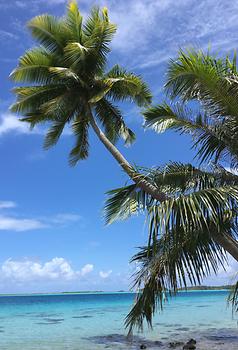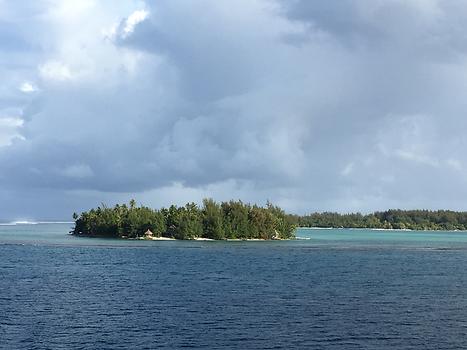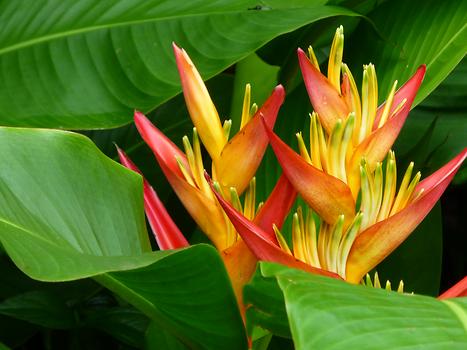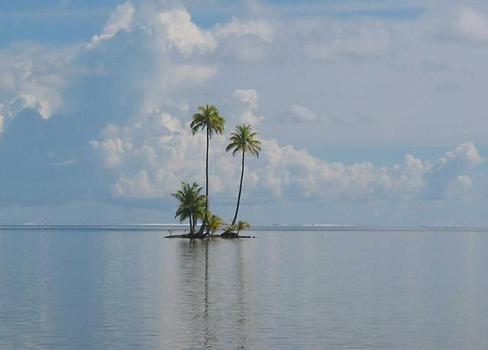Raiatea#
Ra'iātea, is the second largest of the Society Islands, after Tahiti. The islands of Ra'iātea and Taha'a are enclosed by a single coral reef. Ra'iātea is both the largest and most populated island in the Leeward Islands, with a land-area of almost 170 square kilometers and a total population of over 12,000 according to a 2007 census. The largest town of Ra'iātea is 'Uturoa (Ruturoa) on the north side of Ra'iātea. It has a population of nearly 10,000 and is less than 15 km from Bora-Bora.
Relative position of Bora-Bora (left upper island), Tahaa, Raiatea and Huahine in the East.
Tourism has gained much importance only at the very end of the last century, even though it always was a palm-fringed blue-lagoon paradise. In the lagoon snorkeling and diving is great as there are many different species of fish and corals. For those who prefer activities on land, the mountains offer hikers wonderful vistas and hidden waterfalls.







As peaceful as above pictures seem to indicate, hords of tourists have also changed the face of Raiatea, and quite suprising developments have taken place. The traveller M. Reruam permitted to reproduce some of his personal notes:
"I visited Raiatea the first time in 1992 and fell in love with it. As a matter of fact, this laid-back island with little infrastructured appealed to me so much that I purchased a large junk of property next to the waterfall shown above and extending down to the sea. I gave it up years later when things from my point of view deteriorated (everything was modernized and made to fit the taste of tourists), but let me start with my arrival at the airport at Uturoa on the norhtern tip of the island in 1992, flying in from Papeete. (I could have also taken a flight to Bora-Bora and a short hop on a boat as I also did later, when schedules did not fit.)
Uturoa was, despite being capital of a larger region, a small village. The only hotel then available was mediocre, so I stayed in a bed and breakfast (with dinner) place, almost like a house-guest, run by an resolute woman Ms. Minh (Minh is a first name) from Vietnam, having left there when her husband was killed.
She treated me almost like a son, nice and problematic at the same time: On the one hand she made sure that I had a good introduction so some of the "important" persons on the island, on the other hand she dictated my life by planning all my activities. In this sense I feel pity with the person in the picture, who is clearly sitting on the shore of a motu waiting for a boat to pick him up again (as happened more than once to me).
I had a rental car (yes, there was such an agency on the island) and Minh's place was quite a bit southeast of the city, so I went for her to the grocery store. Mentioning her name was enough to be treated with a drink, with lots of time and stories, also about stuff the guy had in stock but was unable to sell. When he mentioned that "crate of horrible French red wine" he caught my attention: He showed me a crate of 12 Northern Rhône Syrah (probably a value of then some US $500.-) and wanted to GIVE it to me, but he could not believe it when I gave him a few dollars for it, beyond the bill for the other groceries: "my lucky day", he insisted.
I wanted to go diving. Jean Phillipe had a dive outfit (or was it just a hobby?). Anyway, he had some slightly obsolete equipment and took me (just us two) on many dives. When in 1995 I told him I would not be coming for some time he said: "Ok, I will show you a huge lone shark tomorrow. No danger, we have known each other for quite long." Well, next day did not go smoothly. The shark was nervous or hungry, and swam attack. In the background there was a sword-fish. When it saw the shark intending to attack us it changed course and attacked the shark: the sword fish saved our lives! Believe me: I will never eat a sword fish steak again in my life.
Well, there was no good restaurent to take Minh out in the early nienties. So I had to try (fortunately successfully ) to cook a few times for us... the first time I saw her in tears! Just to see how things have changed since: There are now a dozen good retaurants in Ruturoa and Raiaetea. That the Trip Advisor recommends the indeed excellent Opoa Beach Hotel Restaurant as best restaurant for Ruturao is almost a joke, since Opoa Beach is some 40 minutes drive southeast of the city.
However, this part of island had one of the biggest surprises in store for me. Some 10 km north of Opoa Beach I found some remnnants of old Polynesion civilization, low walls, some areas paved with stones, quite unintersting. I am still sorry I did not pursue this further as hobby archeologist! I had, without realizing it, discoverd the remains of Marea Taputapuatea

Marae Taputapuatea is a large marae complex at Opoa in Taputapuatea, on the south eastern coast of Raiatea. The site features a number of marae and other stone structures and is considered as at some earlier stage central temple and religious center of Eastern Polynesia.
In 2017 the Taputapuatea area was inscribed on the UNESCO World Heritage Sites list with Taputapuatea marae being described as the heart of the site.
And here I had rummaged around, free of charge, in an ancient relgious celebration area. Today, you have to line up to get a reasonably expensive guided tour!
Just to correct some impressions from my first visits 25 year ago: Today, there are good restaurants, good hotels, good diving outfits, and interesting excursions. One diving outfit I tried out recently is Hemnisphere Sub: It was good, their picture gallery is a bit heavy on sharks (have a look at it), but in real life sharks are rare, but beautiful fish and coral are everywhere."


